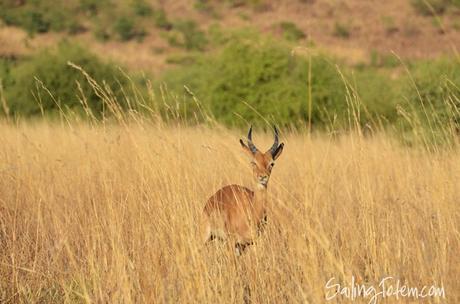
For a long time we have looked forward to visiting Jamie’s aunt and uncle in South Africa. They moved to Johannesburg as expats in the 70s, and have made this country their home. In the 23 years Jamie and I have been together, we’d only seen Barb and Clyde once, on a visit back to Rhode Island that the kids were too young to remember.
After some incredible wildlife reserve and park visits with Ty and Nita, we hopped into a little Chevy rental and headed up to Johannesburg to meet up with family. We knew this would be a fun visit, and they told us we’d take a holiday trip to their timeshare. What we failed to appreciate was that the “timeshare” was a lovely cottage at a four-star private lodge, inside one of the largest game parks in South Africa. As if that wasn’t incredible enough, they booked a full week. Holy moley! It was a spectacular location, and an experience we’d only have thanks to the generosity of our relatives.
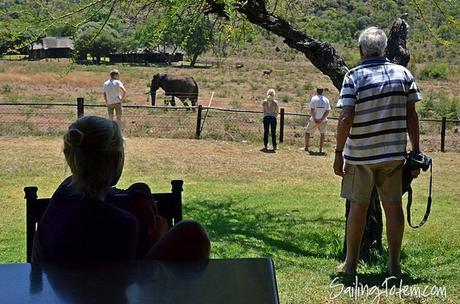
the view from our porch
Our cottage backed right into the park, with just fence between us and the tremendous wildlife. the first morning, Jmie woke me up t some ungodly hour – quickly forgiven, when he pointed out we could see hippo… from bed, through the window, as it ambled up to the watering hole. UNREAL. This was just the beginning, as parade of iconic wildlife passed by our backyard daily.
Pilanesberg Reserve is just a couple of hours drive from Barb and Clyde’s home in Johannesburg. A near perfect circle, it’s the remains of a volcano that’s more than a billion years old: a green marble on the satellite view of the landscape. The mix of wildlife is like the better-known Kruger, a short distance east, but Pilanesburg covers a smaller area with the bonus of fewer people and no malaria risk.
It is breathtaking.

Entering from the south, we left flat lands of dusty red dirt for concentric rings of well-aged hills and savannas. Most of it is terribly dry, as there’s been a multi-year drought; only about 4” of rain has fallen in the last three and a half years when around three feet of rain per year is the norm. This makes tough going for the animals in the park. We spent a lot of time near the largest body of water, the hide at Mankwe dam (pictured bove), as animals were drawn there to drink.
Most watering holes looked more like this, if they had any water at all.
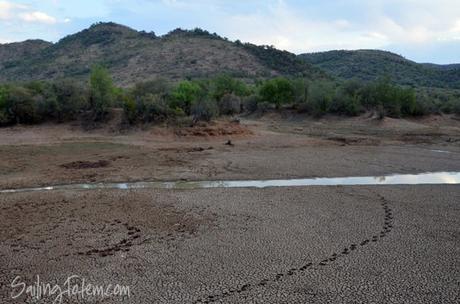
In general, parks provide counts of the resident animals to visitors: Pilanesberg has the gamut of game most people associate with Africa, from rhinos, zebra, giraffe and elephants to a range of antelopes, buffalo, and the big cats.
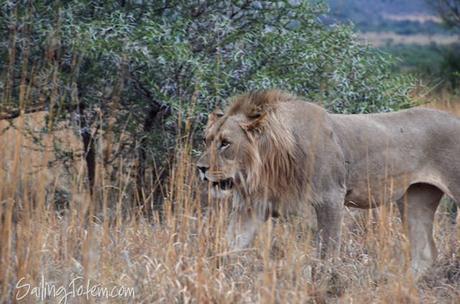
Notably absent from the counts at Pilanesberg and other parks are rhinoceros. There seem to be quite a few—we saw white rhinos every day, and the kids saw the more rare black rhino—but the number isn’t shared publicly, because of the fears it will contribute to poaching. All surviving rhino species are threatened, and most are critically endangered. Unfortunately, poaching has been escalating—especially in South Africa (the increase nearly a hundredfold in less than 10 years)—thanks mainly to the demand for horns in Asian countries. South Africa has the world’s largest rhino populations, but senseless killing means deaths may now overtake births.
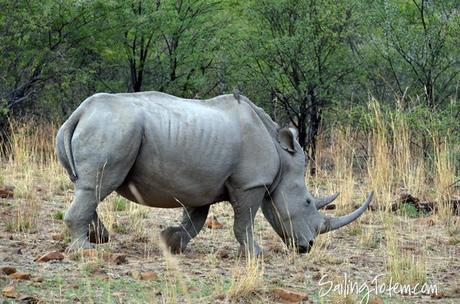
We inquired at the lodge about a nighttime safari, because the cooler nights are often a great time for sightings. They’re off the menu, because of ongoing problems with rhino poaching, and the potential risk to bystanders. The poachers are organized and very well armed.
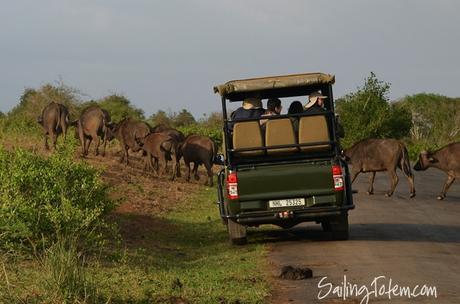
Driving the tracks of Pilanesberg in our little Chevy, we adopted the term “toast racks” (coined by a friend of Barb and Clyde’s) to refer to the group tours in safari trucks. It’s more obvious in a side view, where the toasted visitors sit in nice rows. They have the advantage of height to see over the dry grass; we occasionally felt the disadvantage of being in a lower car, especially after the slightly elevated ride in the VW van to Hluhluwe. Mostly, we were so close, it really didn’t matter.
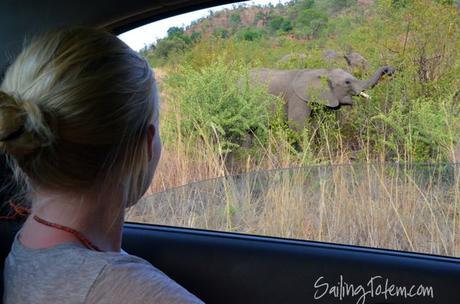
The week was full of indelible memories. Two nights in a row, one of the park’s bull elephants changed our plans by mock-charging down the road towards oncoming vehicles, blocking our exit from the park. The first time, we reversed for more than a quarter of a mile until the elephant decided the games were over. A little stressful! This bull is in musth, and could change from mock charging to a serious threat in a heartbeat. The second night, we had to take an extended detour, on unlit dirt roads, behind a roaring toast rack truck with a ranger that waved us on with a game smile and a call to “follow me!”.
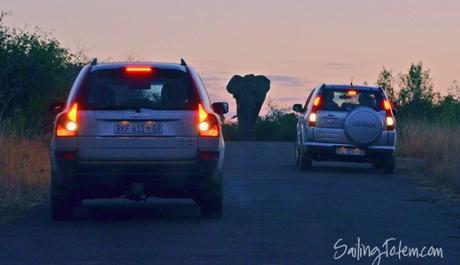
We later met a couple who had this same bull gore their car door.
The days were insanely hot, with early South African summer weather often pushing past 100F. We kept our drives to the extremes of the day for the most part, and retreated during the steamy peak. Late afternoon drives, ending with gin and tonics in one of the many hides: what’s not to love?
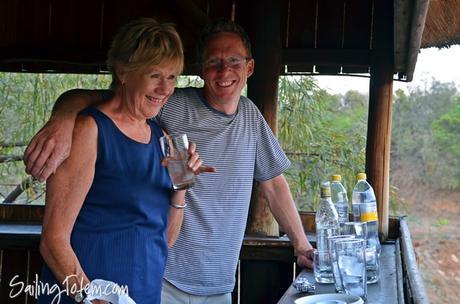
Jamie and Barb set us up
During the hottest hours back at the cottage, we were still treated to sightings like this one: elephants regularly come to the watering hole that the lodge is loosely framed around.
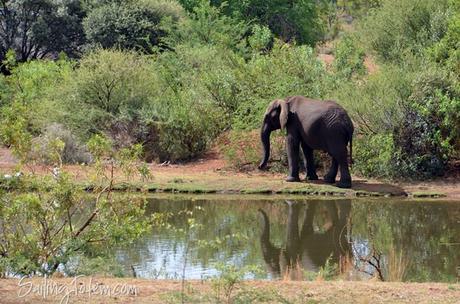
Niall and Siobhan try to sneak up on warthogs, passing by just outside the fence behind the cottage.
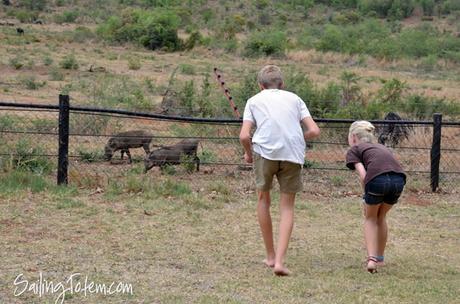
For all of their crazy tusks and prancing gate (complete with tails that stick up like flagpole when agitated), they really are kind of cute.

We typically split between two cars, with the kids taking turns riding with their great aunt and uncle. Clyde is a superb photographer, and gave me lots of great tips that I’m working on incorporating.
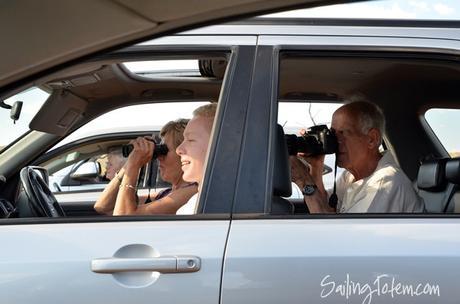
They knew the park well, as well as many of the rangers, a nice boost for getting tips on the latest spottings! One of the sightings that has stuck with us the most is this hyena, scavenging from what looked like little more than bones and dessicated skin from this carcass in the dusty basin of a dried-up water hole.
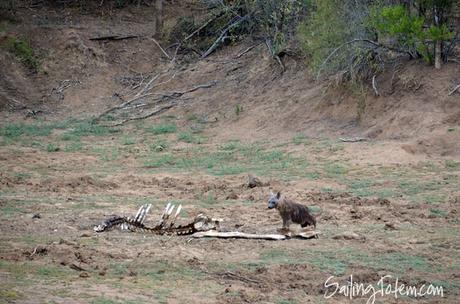
I was also so grateful, after looking for days, to finally spot a distant kudu with a magnificent set of horns.
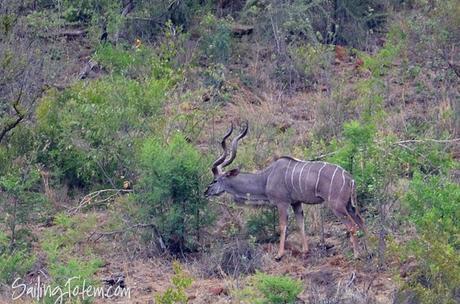
On our last morning drive, this lioness and her bloody muzzle peeked through the shrubs from a wildebeest had been killed.
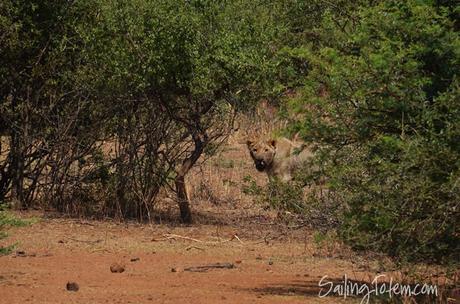
Every drive included plenty of zebra, like this pair that chased each other–and a springbok–while playing near a dam.
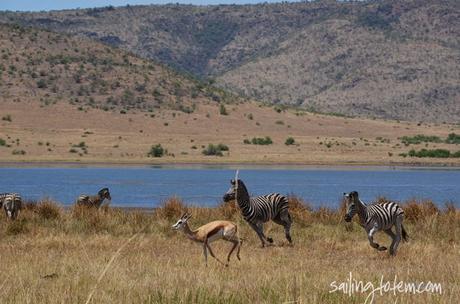
An incredible week, one that gave all five of us memories for a lifetime: thank you Barb and Clyde!
This post is syndicated on Sailfeed.

